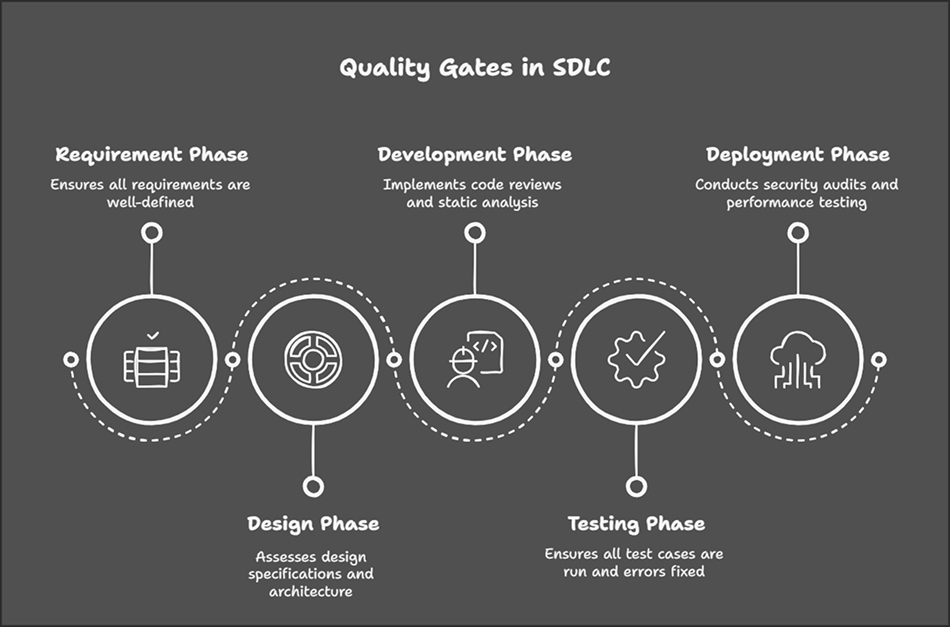Using quality gates is one of the most reliable ways to ensure quality is maintained within the software development life cycle (SDLC). These gates check whether a project meets certain standards before moving to the next stage of the project.
The Role of Quality Gates in SDLC
Quality gates can be integrated into each stage of the software development lifecycle to ensure swift progress.
1. Requirement phase
In this phase, quality gates ensure that requirements are well-defined, feasible, and aligned with business goals. You can also include stakeholder validation and traceability checks.
2. Design phase
Quality gates assess whether design specifications and system architecture meet predefined standards. They can include design reviews, feasibility analysis, and architectural validation.
3. Development phase
Code reviews, static application security testing (SAST), and automated testing serve as quality gates to ensure code maintainability, security, and performance.
4. Testing phase
Quality gates in testing ensure that critical test cases pass, defects meet an acceptable threshold, and that functional, security, and performance testing are completed before moving forward.
5. Deployment phase
The final quality gate ensures that the software is production-ready. This can involve compliance checks, security audits (e.g., penetration testing), performance validation, and rollback planning.
Benefits of implementing quality gates
1. Early defect detection
- Quality gates continuously assess the development process to help teams identify and fix issues early.
- This reduces the risk of severe defects reaching production, creating a more stable final product.
2. Reduced rework and cost
- Verifies the output of every stage of SDLC against predefined quality standards.
- This minimizes the need for rework, reducing development costs and resource waste.
3. Improved product quality
- Ensures the software functions as expected, improving reliability, security, and maintainability.
4. Better security compliance
- Security-focused quality gates, such as SAST, DAST, and dependency scanning, help prevent vulnerabilities from being introduced into production.
- This is especially critical for regulatory compliance in industries like finance and healthcare.
Challenges in implementing quality gates
1. Excessively strict gates
- Overly complex quality gates can create bottlenecks, delaying releases.
- To mitigate this, teams should define risk-based and adaptive criteria that allow low-risk changes to proceed while enforcing stricter checks on high-impact modifications.
2. Lack of automation
- Manually enforcing quality gates is time-consuming and prone to inconsistencies.
- Automating testing, security scanning, and compliance checks ensures efficiency, repeatability, and reliability.
3. Ignoring early-stage inspections
- Delaying quality checks will increase the cost of fixing defects.
- Implementing static analysis and unit testing can prevent costly rework and accelerate development.
4. False positives in automated checks
- Automated security scans and linting tools may generate false positives.
- This can lead to alert fatigue, where developers start ignoring warnings.
- Teams should fine-tune their tools and prioritize high-confidence alerts.
Best practices for effective quality gates
- Establish measurable and simple criteria: Define clear, objective, and quantifiable requirements for each quality gate.
- Code quality checks (e.g., maintainability scores, cyclomatic complexity).
- Test coverage thresholds (e.g., unit test coverage ≥ 80%).
- Security policies (e.g., no critical vulnerabilities in dependencies).
- Performance benchmarks (e.g., API response time < 200ms).
- Ensure each gate has pass/fail criteria helps automate decision-making and prevents ambiguity.
- Frequent audits and reviews: Quality gates should be continuously checked and improved through periodic reviews. Conducting regular audits ensures that:
- Gates remains relevant and aligned with industry standards.
- New risks (e.g., evolving security threats) are addressed.
- Continuous feedback and improvement loops: A well-implemented DevOps quality gate must support continuous feedback, allowing teams to address issues early in the development cycle.
- Run quality checks earlier (e.g., pre-commit hooks, static analysis before PR merges).
- Integrate quality gate results with Slack, Microsoft Teams, or GitHub PR comments for real-time developer feedback.
- Adjust quality thresholds dynamically based on historical defect rates, risk levels, or team velocity.
Conclusion
Integrating continuous delivery quality gates is one of the most proactive ways to guarantee the overall quality of the software. With quality gates, development teams can identify and mitigate vulnerabilities early before they become severe issues. Quality gates set the development pace while maintaining high standards, allowing the final application to be completed within the specified time limits.

